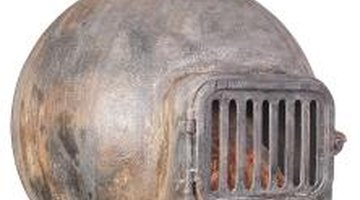The Curing Process for Wood Stove Paint
Wood stove paint is durable and tough so that it can resist high heat. To do this, high heat paint needs to be cured so it has a tough and durable shell. The curing method can vary depending on the type and brand of paint, but many have a similar curing process. Consult your specific paint brand instructions for more details.
Painting Process

High heat paint includes resin, which will quickly dry at room temperature. Resin paint will take several hours to dry and can feel slightly sticky. The paint will appear glossy when it is first applied and once it air dries.
The Process
Curing the paint requires you to heat the wood stove over 475 degrees Fahrenheit several times to harden. High heat paint has two types of resin, one of which dries at room temperature and another that dries at high heat. The heating process allows the silicone resin to dry and for the paint to harden completely and form a tight seal with the wood stove underneath. Because the silicone resin hasn’t dried completely, the paint will appear wet and soft during the heating process. Cured paint will also appear duller than the initial layer of wet paint.
Curing Slowly
Curing high heat paint on wood stoves can be tricky as you cannot simply set a temperature and wait for the stove to reach it. Instead, you’ll need to build the fire and test the temperature to ensure that it cures correctly. The most important thing is to slowly build the fire so it heats up gradually. If the stove heats up quickly, it will cause the paint to pull away from the metal surface.
Preventing Scratches and Marks
The paint is vulnerable during the curing process. Never place any pans, pots or trivets on the surface until it as cured completely. Don’t touch the stove as you can leave fingerprints in the soft and wet paint surface. The only remedy for this is to sand the paint off and begin the entire process again. .
Health Issues
The curing process causes carbon dioxide to off gas. Prevent health issue such as headaches, difficulty breathing and light-headedness by ventilating the room as much as possible when you are curing the paint. Keep small children, the elderly, pregnant women or those with respiratory difficulties away from the area while you are curing paint. Move birds and small pets to another, well-ventilated area of your home.
References
Writer Bio
Kaye Wagner has been working in the fields of journalism and public relations since 2006 and is a recipient of a National Hearst Award. She is particularly interested in home-and-garden projects, as well as beauty and fashion writing. An avid traveler, she also writes travel reviews and guides. Wagner earned a Bachelor of Arts in journalism from Brigham Young University.
Photo Credits
- Hemera Technologies/PhotoObjects.net/Getty Images
More Articles



